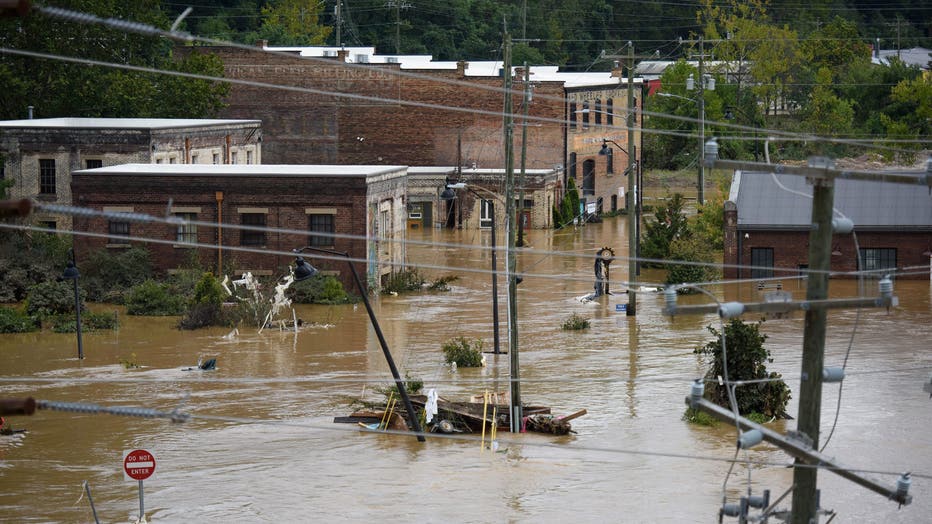Fewer than 2% of people in counties hit hardest by Helene have flood insurance: report
Viral meteorologist tracks Helene's aftermath
Widespread devastation left behind by Hurricane Helene came to light Monday across the South, revealing a wasteland of splintered houses, crushed cargo containers and mud-covered highways in one of the worst storms in U.S. history. The death toll topped 130. LiveNOW from FOX host Josh Breslow spoke to viral meteorologist Ethan Clark on what he's seen so far.
In the 100 counties hit hardest by Hurricane Helene, fewer than 2% of homeowners are protected by flood insurance, NBC News reports.
In the mountain towns of North Carolina and parts of Northwest South Carolina, where Helene decimated entire communities, the figures are even more grim. According to an NBC News analysis, fewer than 1% of the North Carolina counties with the most flood damage from Helene were covered. In South Carolina, it’s 0.3%.
In Florida, Georgia, North Carolina, South Carolina, Tennessee and Virginia, about 5% of residences have flood insurance, but those policies are mainly along the coast.
RELATED: Helene forces closure of North Carolina quartz facilities, disrupting tech supply chain
According to FEMA, one inch of floodwater can cause up to $25,000 in damage. Countless homes and businesses saw several feet of water from Hurricane Helene. Floods have caused about $108 billion of damage in the U.S. since 2000.

Heavy rains from hurricane Helene caused record flooding and damage on September 28, 2024 in Asheville, North Carolina. Fewer than 1% of people in counties hit hardest there have flood insurance. (Photo by Melissa Sue Gerrits/Getty Images)
What’s the difference between homeowners insurance and flood insurance?
Many homeowners don’t realize that basic homeowners insurance does not cover damage from floods: Flood insurance must be purchased as a separate policy.
READ MORE: Hundreds of US troops battle devastation caused by 'biblical' Helene floods
More than 95% of flood insurance policies are sold through the government-run National Flood Insurance Program. The NFIP is administered through FEMA via a network of more than 50 insurance companies and the NFIP Direct.
Helene aftermath: Roads heavily damaged by storm
Helene damaged roads and interstates across several states, including North Carolina. Jen Goodwin with the North Carolina Department of Transportation joined LiveNOW from FOX's Josh Breslow to discuss the situation in the state.
The FEMA program is often the only flood insurance available in areas vulnerable to hurricanes and heavy rains.
National Flood Insurance Program unaffordable for many
In 2021, FEMA began to phase in new rates for the National Flood Insurance Program, which allow annual flood insurance increases up to 18%.
That led to 10 states suing the federal government to block FEMA from implementing the changes. Florida, Idaho, Louisiana, Kentucky, Mississippi, Montana, North Dakota, South Carolina, Texas and Virginia joined in the suit.
MORE: Join the effort: How you can help Hurricane Helene's devastated communities
FEMA says the new method of computing rates has resulted in reductions or little or no increase for most policy-holders, but FEMA figures also show huge impending increases in some ZIP codes, especially for flood-prone South Louisiana.
President Biden remarks on Helene damage in North Carolina
President Joe Biden to the Carolinas to assess the devastation wrought by Hurricane Helene. At least 174 people have been confirmed dead in six states - Florida, Georgia, South Carolina, North Carolina, Virginia and Tennessee. Biden's trip comes as he announced that he has ordered the deployment of up to 1,000 active-duty soldiers to support the delivery of essential food, water and other commodities to areas devastated by the storm.
FEMA has said its new premium system is an improvement over past methods, incorporating data that wasn’t used in the past, including scientific models and costs involved in rebuilding a home.
The agency has said the old method could result in people with lower-valued homes paying more than a fair share, while those with higher-value homes pay relatively less.
Louisiana officials argue that increases in federal flood insurance premiums are projected to surpass 700% over the coming years. They say the changes are already leading people to back out of home purchases and will likely lead to an exodus of residents and businesses.

